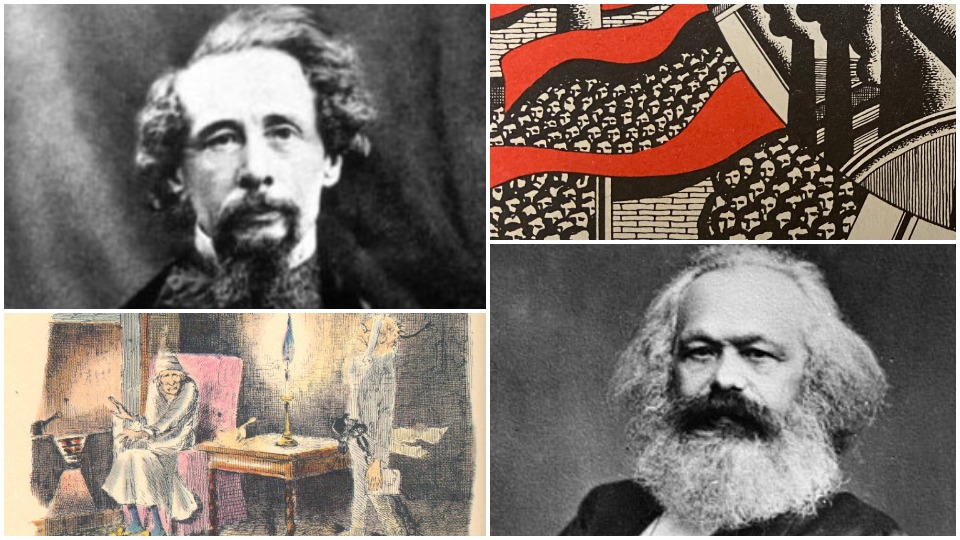
It has often been pointed out that Karl Marx and Charles Dickens inhabited the same London streets for over 20 years.
They were both appalled by the squalor the Industrial Revolution brought with it, particularly to the streets of Manchester and London. It was this, after all, that inspired their best-known works, published within five years of each other.
The way we celebrate Christmas today probably has more to do with Dickens than Christians would ever like to admit. His work defines what we think of as the Victorian Christmas, establishing many practices imported from the German bourgeoisie and popularized in England by Prince Albert.
A Christmas Carol was published in 1843, and by the end of 1844, at least 13 editions had been printed. It has not been out of print since, and goodness knows how many theatrical, radio, and film adaptations have been produced, including my favorite, Scrooge (1951)—the interplay between Alistair Sim as Scrooge and Kathleen Harris as Mrs. Dilber, his charwoman, is a delight.
There wasn’t long to wait for Marx’s bestseller, The Communist Manifesto, which was published a scant five years later, in 1848. It too has never been out of print. I think I have at least six different editions, although I’m still waiting for a decent film!
There is no doubt that Marx was a reader of Dickens, as there are numerous references from Dickens in his writings. He identifies Dickens’s characters with real individuals and social types of the time.
Mr. Pecksniff from Martin Chuzzlewit (1842-4) is the one most frequently invoked by Marx. He is the personification of the cant and humbug which conceals capitalist exploitation. Pecksniff’s long-winded pleasantries and moralizing about “virtue” and “truth,” his presenting himself to his employees and community as goodness personified, even naming his daughters Mercy and Charity, made him a recognizable type for Marx to utilize.
It would be nice to think, too, that Marx’s use of the metaphor of the spectre that begins The Communist Manifesto, “A spectre is haunting Europe…” so soon after those in A Christmas Carol, is more than coincidental.
It was Francis Wheen who first pointed out in his Karl Marx: A Life (1999)—at least to me—that Capital reads like a Victorian novel. Some critics find this demeans Marx’s masterwork by turning it into fiction. I take the opposite view: It turns it into literature.
Wheen identified what he called “a Dickensian texture” in Capital. Something I had noticed on reading it myself, a texture which can be partly traced to the fact that both Dickens and Marx present a society characterized by the “personification of things and the reification of persons” (Personificirung der Sache und Versachlichung der Personen)—a technique that brings tremendous clarity to what are sociological types.
Marx may have been in exile in England, but when it came to Christmas, he was a good bourgeois German, although his income did not always allow him to appear that way.
Thank goodness for Engels. On Dec. 24, 1866, Jenny Marx wrote to Engels:
“My dear Mr. Engels,
My most heartfelt thanks for the Christmas hamper. The champagne will be a tremendous help in tiding us over the otherwise gloomy holiday, and will ensure a merry Christmas Eve.
“The sparkling bubbles of the champagne will make the dear children forget the lack of a little Christmas tree this year, and be happy and jolly for all that.”
I’ve always found, as a champagne socialist who prefers his tipple from the Co-op, that the bubbly does help me to get through the gloomy season. Although it’s far too good for the children.
Reading the correspondence between the family and “the General”—old man Engels—it seems that it was indeed he who embraced the Christmas season with the greatest enthusiasm.
In his memoir of his time in exile in London, Eduard Bernstein records “an evening at Engels’” which preceded the Christmas celebrations.
“It was on the day when the dough, or rather paste, for the Christmas puddings was prepared. An enormous quantity was made, for there was not a single friend of the house who did not receive a Christmas pudding from 122 Regent’s Park Road … about a fortnight before Christmas, the lady friends of the house turned up early in the morning, and worked on until the evening, chopping great heaps of apples, nuts, almonds, candied peel, etc., into little bits, and stoning and chopping pounds upon pounds of raisins; and as may be supposed it was a thoroughly cheerful party: As the ingredients were prepared they were put into a huge tub.
“Later in the evening the male friends of the house arrived, and each of them was required to lay hold of a ladle that stood upright in the tub, and stir the paste three times round; a by no means easy task, which needed a good deal of muscular strength.
“But it had rather a symbolical meaning, and those whose strength was inadequate were mercifully exempted. The concluding touch was given by Engels himself, who descended into the wine-cellar and brought up champagne, in which we drank to a merry Christmas and many other things as well.”
There’s the champagne again, and everyone got Christmas pudding. That’s my kind of Christmas. However, looking at the TV schedule you may need a good book for the coming gloomy holiday, so if Dickens doesn’t appeal, you could do no worse than follow the example of Rev. Martin Luther King, Jr., who from Dec. 23, 1949, to Jan. 2, 1950, spent his Christmas holiday reading and “carefully scrutinizing” the three-volume Victorian novel better known as Capital, together with The Communist Manifesto.
However you choose to spend the holidays, Happy Christmas, one and all.










